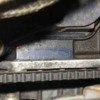Jerry,
D0PF indicates a replacement carb. D=1970's (decade) 0=70 (specific year) and P indicates parts system. F=fuel stuff......AF is a particular revision. 0L23 could be 1970, November 23rd when it was produced.
The fact that it says Autolite on the tag means it was replaced VERY early! Motorcraft appears on tags in 71-72 timeframe....
I would have expected a C8ZF-xx tag on an original carburator, as it would have been the same carb found on a stick shift 1968/69 Mustang with a 302-4V (non-Boss).
I wouldn't be too upset.....with the fact that it isn't original. It is still exactly the same type carb. NO ONE would know different until they lift the air cleaner and check out this little tag!
As for the engine tag, you can see 302 for displacement, C is the plant code, 68 for year, 1 for Change level(US built). I believe the 8-G indicates 68, July as month of production.
The 283-J is an engine code that you will find in the Ford parts books, at the beginning of the engine pages in the Master Parts Catalog.
283 lists a 302 Ford carb 4-barrel (as opposed to a Holley 4V) with warranty plate code "J". This J appears in the VIN in the 5th digit I believe in Mustangs Cougars, etc. So when someone says I have a 68 J-code Mustang, there was an Autolite 4V equipped 302 in their car originally!
So, that is what I can tell you about that!
Ciao!
Steve


